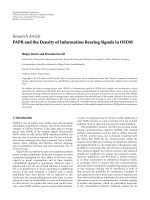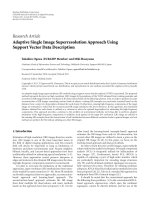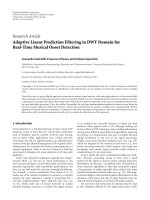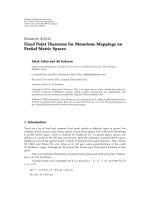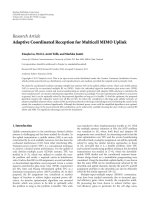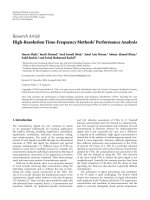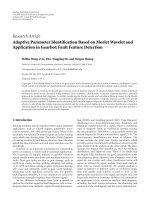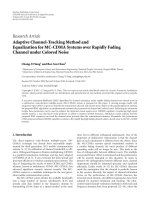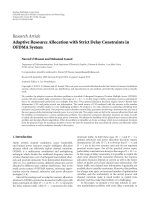Báo cáo hóa học: " Research Article Adaptive Resolution Upconversion for Compressed Video Using Pixel Classification" doc
Bạn đang xem bản rút gọn của tài liệu. Xem và tải ngay bản đầy đủ của tài liệu tại đây (1.17 MB, 6 trang )
Hindawi Publishing Corporation
EURASIP Journal on Advances in Signal Processing
Volume 2007, Article ID 71432, 6 pages
doi:10.1155/2007/71432
Research Article
Adaptive Resolution Upconversion for
Compressed Video Using Pixel Classification
Ling Shao
Video Processing and Analysis Group, Philips Research Laboratories, High Tech Campus 36, 5656 AE Eindhoven, The Netherlands
Received 22 August 2006; Accepted 3 May 2007
Recommended by Richard R. Schultz
A novel adaptive resolution upconversion algorithm that is robust to compression artifacts is proposed. This method is based
on classification of local image patterns using both st ructure information and activity measure to explicitly distinguish pixels into
content or coding artifacts. The structure information is represented by adaptive dynamic-range coding and the activity measure is
the combination of local entropy and dynamic range. For each pattern class, the weighting coefficients of upscaling are optimized
by a least-mean-square (LMS) training technique, which trains on the combination of the original images and the compressed
downsampled versions of the original images. Experimental results show that our proposed upconversion approach outperforms
other classification-based upconversion and artifact reduction techniques in concatenation.
Copyright © 2007 Ling Shao. This is an open access article distributed under the Creative Commons Attribution License, which
permits unrestricted use, distribution, and reproduction in any medium, provided the original work is properly cited.
1. INTRODUCTION
With the continuous demand of higher picture qualit y, the
resolution of high-end TV products is rapidly increasing.
The resolution of broadcasting programs or video on stor-
age discs is usually lower than that of high-definition (HD)
TV. Therefore, those video materials have to be upconverted
to fit the resolution of the HDTV. Due to the bandwidth
limit of the broadcasting channels and the capacity limit of
the storage media, the v ideo materials are always compressed
with various compression standards, such as MPEG1/2/4 and
H.26x. These block-transform-based codecs divide the im-
age or video frame into nonoverlapping blocks (usually with
the size of 8
× 8 pixels), and apply discrete cosine transform
(DCT) on them. The DCT coefficients of neighboring blocks
are thus quantized independently. At high or medium com-
pression rates, the coarse quantization will result in various
noticeable coding artifacts, such as blocking, ringing, and
mosquito artifacts.
Most existing resolution upconversion algorithms ap-
ply content-adaptive interpolation according to the struc-
ture or property of a region [1–7]. For compressed mate-
rials, the coding artifacts will be preserved after upscaling.
These coding artifacts, for example, blocking artifacts, will
be even more difficult to remove than those in the original
low-resolution image, because the coding artifacts w ill
spread among m ore pixels and become not trivial to detect
after upscaling. One solution is to reduce the coding artifacts
before applying resolution upscaling. However, most coding
artifact reduction algorithms [8–11] blur details while sup-
pressing various digital artifacts. Those details lost during
artifact reduction cannot be recovered during resolution up-
scaling. We propose to remove coding artifacts and apply res-
olution upconversion simultaneously in this paper. Different
filter coefficients are used for different image regions based
on a classification scheme that utilizes both structure and
an activity metric. The optimal coefficients are obtained by
making the mean square error (MSE) between the reference
pixels and the processed distorted pixels minimized statisti-
cally during the training process. The distortion we use here
is first downsampling then adding coding artifacts by com-
pression.
Most superresolution algorithms [12, 13] in the litera-
ture attempt to recover high-resolution images from low-
resolution images based on multiframe processing. We pro-
pose a single-frame processing solution for resolution up-
conversion of compressed images and video. Therefore, the
proposed technique is more efficient and cost-effective.
The rest of this paper is organized as follows. Section 2
describes the classification method that determines whether
a local region contains information or digital artifacts.
2 EURASIP Journal on Advances in Sig nal Processing
Table 1: Coarse classification of a region.
DR Entropy (high) Entropy (low)
DR (high) Object edge/highly textured region Strong blockiness
DR (low)
Fine texture Mild blockiness/mosquito noise
100 104 108
102 105 52
98 55 50
ADRC
111
110
100
Figure 1: Illustration of ADRC coding.
In Section 3, we present the least-mean-square technique to
obtain the optimized coefficients for each class. Experimen-
tal results and performance evaluation are given in Section 4.
Finally, we conclude our paper in Section 5.
2. PIXEL CLASSIFICATION
Adaptive dynamic-range coding (ADRC) [14]hasbeensuc-
cessfully used for representing the structure of a region. The
ADRC code of each pixel x
i
in an observ ation aperture is de-
fined as ADRC(x
i
) = 0ifV(x
i
) ≤ V
av
, 1 otherwise, where
V(x
i
) is the value of pixel x
i
,andV
av
is the average of all the
pixel values in the aperture. Figure 1 shows the ADRC coding
of a 3
× 3 aperture. ADRC has been demonstrated to be an
efficient classification technique for resolution upconversion
[1]. However, obviously it is not enough for compressed ma-
terials, because it cannot distinguish object details from cod-
ing artifacts. For example, the ADRC codes of an object edge
could be exactly the same as that of a blocking artifact. There-
fore, local activity measure should be appended to ADRC, in
order to fully differentiate object details from compression
artifacts.
The activity measure we employ is the local entropy cou-
pled by dynamic range of a region. Local entropy has been
shown to be a good measure for distinguishing information
from digital noise [8]. The local entropy is calculated on the
probability density functions (PDFs) of some descriptors in-
side a region. The PDFs are approximated by the histogram
of a descriptor. Considering the context of video processing,
we employ luminance intensity as the descriptor. Therefore,
the entropy calculation can be defined as
H
=−
N
i=1
P
R
(i)log
2
P
R
(i), (1)
where i indicates the bin index in the histogram, N is the to-
tal number of bins, and R is a local region around the central
HD images
2D downsample
Codec
HD-derived SD images
with coding artifacts
ADRC + activity
classification
LMS
optimization
per class
Store upscaling
coefficients for
each class in LUT
Figure 2: The training procedure of the proposed method.
pixel over which the entropy is calculated. A region w ith high
activity has a distributed histogram, while the histogram of
a region with low activity usually only contains a few peaks.
Note that the distribution of the histogram is dominated by
the local structure of the region, such that noise and cod-
ing artifacts will not affect the overall distribution of the his-
togram.
According to the information theory, H has a higher
value for a spread-out histogram than a peaked one [8], that
is, the entropy value of a complex region tends to be larger
than a smooth region. Entropy H can be also used as a lo-
cal blockiness met ric, because blocking artifacts reduce the
variation of intensities, thus decrease the entropy value. Typ-
ically, the entropy value of a region decreases when increasing
the compression rate.
To further quantize a region’s activity or coding ar tifacts,
entropy should be coupled with dynamic range (DR). DR is
defined as the absolute difference between the maximum and
minimum pixel values of a region. Ta ble 1 depicts a coarse
classification of a region based on the combination of en-
tropy and dynamic range. Here, each 1 bit is used for both
entropy and DR. Ringing artifact can be also differentiated,
because it usually has a medium-valued entropy and a rela-
tively low DR. For more detailed description of the classifica-
tion method based on entropy and DR, please refer to [9].
Accordingly, a pixel and its surrounding region can be
classified based on the structure, which is represented by
ADRC, and the activity measure, w hich is the local entropy
plus dynamic range.
3. LEAST-MEAN-SQUARE OPTIMIZATION
In this section, the least-mean-square (LMS) optimization
technique is described to produce optimal coefficients for
Ling Shao 3
Input SD image
Filtering
Output HD image
ADRC + activity
classification
Upscaling
coefficients
LUT
Figure 3: The filtering procedure of the proposed method.
each class based on the pixel classification of the previous
section. Figure 2 shows the proposed optimization proce-
dure. Uncompressed HD reference images are first down-
sampled using bilinear interpolation. The downsampled im-
ages are then compressed to introduce coding artifacts. We
refer to the compressed downsampled images as corrupted
images. Each pixel in the corrupted images is then classified
on that pixel’s neighborhood using the classification method
described in the previous section. All the pixels and their
neighborhoods belonging to a specific class and their corre-
sponding pixels in the reference images are accumulated, and
the optimal coefficients are obtained by making the mean
square error (MSE) minimized statistically.
Let F
D,c
, F
R,c
be the apertures of the distorted images
and the reference images for a particular class c,respectively.
Then, the filtered pixel F
F,c
can be obtained by the desired
optimal coefficients as follows:
F
F,c
=
n
i=1
w
c
(i)F
D,c
(i, j), (2)
where w
c
(i), i ∈ [1 ···n], are the desired coefficients, n is the
number of pixels in the aperture, and j indicates a particular
aperture belonging to class c.
The summed square error between the filtered pixels and
the reference pixels is
e
2
=
N
c
j=1
F
R,c
− F
F,c
2
=
N
c
j=1
F
R,c
( j) −
n
i=1
w
c
(i)F
D,c
(i, j)
2
,
(3)
where N
c
represents the number of pixels belonging to class
c. To minimize e
2
, the first derivative of e
2
to w
c
(k), k ∈
[1 ···n], should be equal to zero:
∂e
2
∂w
c
(k)
=
N
c
j=1
2F
D,c
(k, j)
F
R,c
( j) −
n
i=1
w
c
(i)F
D,c
(i, j)
=
0.
(4)
By solving the above equation using Gaussian elimination,
we will get the optimal coefficients as follows:
⎡
⎢
⎢
⎢
⎢
⎢
⎢
⎢
⎣
w
c
(1)
w
c
(2)
.
.
.
w
c
(n)
⎤
⎥
⎥
⎥
⎥
⎥
⎥
⎥
⎦
=
⎡
⎢
⎢
⎢
⎢
⎢
⎢
⎢
⎢
⎢
⎢
⎢
⎢
⎢
⎢
⎢
⎢
⎣
N
c
j=1
F
D,c
(1, j)F
D,c
(1, j)
.
.
.
N
c
j=1
F
D,c
(1, j)F
D,c
(n, j)
N
c
j=1
F
D,c
(2, j)F
D,c
(1, j) ···
N
c
j=1
F
D,c
(2, j)F
D,c
(n, j)
.
.
.
.
.
.
.
.
.
N
c
j=1
F
D,c
(n, j) F
D,c
(1, j) ···
N
c
j=1
F
D,c
(n, j) F
D,c
(n, j)
⎤
⎥
⎥
⎥
⎥
⎥
⎥
⎥
⎥
⎥
⎥
⎥
⎥
⎥
⎥
⎥
⎥
⎦
−1
×
⎡
⎢
⎢
⎢
⎢
⎢
⎢
⎢
⎢
⎢
⎢
⎢
⎢
⎢
⎢
⎢
⎣
N
c
j=1
F
D,c
(1, j)F
R,c
( j)
N
c
j=1
F
D,c
(2, j)F
R,c
( j)
.
.
.
N
c
j=1
F
D,c
(n, j) F
R,c
( j)
⎤
⎥
⎥
⎥
⎥
⎥
⎥
⎥
⎥
⎥
⎥
⎥
⎥
⎥
⎥
⎥
⎦
.
(5)
The LMS-optimized coefficients for each class are then stored
in a lookup table (LUT) for future use. Figure 3 shows the fil-
tering procedure of resolution upconversion for compressed
materials using the optimized coefficients retrieved from the
LUT. A more comprehensive explanation of the LMS opti-
mization technique can be found in [1].
4. EXPERIMENTS AND EVALUATION
In this section, the experimental results of the proposed
algorithm are presented. For the optimization procedure,
a set of 500 images is used for training. We demonstrate
the algorithm with the upscaling factor of 2
× 2. There-
fore, the bilinear interpolation with the scaling factor of
2
× 2 is used for downsampling during training. O bviously,
other upconversion factors can also be achieved. The baseline
JPEG software from the Independent JPEG Group website
()isadoptedtobethecodecforintroduc-
ing coding artifacts. The quality factor of JPEG is set to be 20.
Obviously, other codecs, such as MPEG or H.264, can also
be used. An aper ture of 3
× 3 pixels, as depicted in Figure 4,
is used for classification in our implementation. Therefore,
8 bits are needed for ADRC coding, since 1 bit can be saved
by bitinversion [15]. For the activity measure, we use 2 bits
for local entropy and 2 bits for dynamic range. Totally, 12 bits
are used for classification.
4 EURASIP Journal on Advances in Sig nal Processing
Table 2: Comparison of numbers of coefficients in the LUT of the three algorithms.
Algorithm Reference [15] + reference [1] Refer ence [1] + reference [15]Proposed
No. coefficients 4096 × 16 × 13 + 256 × 9 256 × 9 + 4096 × 16 × 13 256 × 16 × 9
Table 3: MSE comparison of different algorithms.
Sequence Reference [1] Refer ence [15] + reference [1]Reference[1] + referenc e [15]Proposed
Hotel 116.28 113.40 108.53 104.92
Parrot
36.13 32.15 35.05 31.92
Girl
66.93 59.85 63.72 59.42
Bicycle
183.48 164.25 170.19 161.43
Helicopter
89.01 89.81 83.07 82.85
Game
208.80 209.74 198.27 192.82
For benchmarking, we compare our algorithm with
two state-of-the-art classification-based resolution upcon-
versions [1] and artifact reduction [15] methods in con-
catenation. ADRC is used for classification in the resolution
upconversion algorithm. Same as our proposed approach,
a3
× 3 aperture is used for classification and interpola-
tion. The coding artifact reduction method is based on the
classification of structure by adaptive dynamic-range cod-
ing (ADRC) and relative position of a pixel in the coding
block grid. A diamond-shape 13- aperture is used, which re-
quires 12 bits for ADRC and 4 bits for relative position cod-
ing. The drawback of this method is that block grid positions
are not always available, especially for scaled material. For
the cascaded method of first applying resolution upconver-
sion then doing coding artifact reduction, the classification
of coding artifact reduction is carried out on the upscaled
HD signal and the relative position of a pixel in the block
grid is also upscaled accordingly to suit the HD signal. The
coefficients of both methods are obtained by the LMS tech-
nique. These two methods have significant advantages over
other analysis-based filtering techniques. For cost compari-
son, Table 2 shows the numbers of coefficients that need to
be stored in lookup tables (LUT) for each of the three algo-
rithms. The proposed algorithm is much more economical
than the other two in terms of LUT size. Since the training
process is done offline and only needs to be done once, thus
the computational cost is limited for all the three methods.
We test the algorithms on a variety of sequences first
downsampled then compressed using the same setting used
during the tr aining. Figure 5 shows the snapshots of the se-
quences we use. All the test sequences are excluded from the
training set. The objective metric we use is mean square er-
ror (MSE), that is, we calculate the MSE between the origi-
nal HD sequences and the result sequences processed on the
compressed downsampled versions of the original sequences.
Tabl e 3 shows the results of the proposed algorithm in com-
parison to the results of first applying coding artifact reduc-
tion then upconversion and first applying upconversion then
2j 2( j +1) 2(j +2) 2(j +3) 2(j +4) 2(j +5)
2(i +5)
2(i +4)
2(i +3)
2(i +2)
2(i +1)
2i
F
00
SD pixel
HD pixel
F
00
F
01
F
02
F
10
F
11
F
12
F
20
F
21
F
22
A
B
CD
Figure 4: Aperture used in the proposed method. The white pix-
els are interpolated HD pixels (F
HD
). The black pixels are SD pixels
(F
SD
), with F
12
as a shorthand notation for F
SD
(1, 2) and so forth.
The HD pixel A that corresponds to F
HD
(2(i +2),2(j + 2)), is inter-
polated using nine SD pixels (F
00
up to F
22
).
artifact reduction. The result of resolution upconversion us-
ing the method in [1] without applying artifact reduction is
also shown for reference. From the results, one can see that
the proposed algorithm outperforms the other two concate-
nated methods for all sequences. The results also reveal that
the order of applying upconversion and artifact reduction af-
fects the performance of the concatenated method. For some
Ling Shao 5
(a) Hotel (b) Parrot (c) Girl
(d) Bicycle (e) Helicopter (f) Game
Figure 5: Snapshots of test sequences for experiments.
(a) (b) (c)
Figure 6: The cutouts of the girl sequence processed using the three methods: (a) first artifact reduction then resolution upconversion; (b)
first resolution upconversion then artifact reduction; (c) the proposed method.
sequences, applying artifact reduction first gives better re-
sults; for other sequences, vice verse.
For subjective comparison, Figure 6 shows the results of
the three methods on the girl sequence. It is easy to see that
the result of first applying upconversion then artifact reduc-
tion contains more residual artifacts than the proposed algo-
rithm, because upscaling makes coding artifacts spread out in
more pixels and the enlarged coding artifacts are more diffi-
cult to remove. The result of first applying artifact reduction
then resolution upconversion is blurrier than our proposed
algorithm, because the artifact reduction step blurs some de-
tials, which cannot be recovered by the upscaling step.
5. CONCLUSION
In this paper, a compression artifacts robust resolution up-
conversion approach is proposed. Structure and activity in-
formation are employed to classify an aperture into object
details or coding artifacts. Based on the classification, a least-
mean-square optimization technique is used to obtain the
6 EURASIP Journal on Advances in Sig nal Processing
optimized weighting coefficients for upscaling. The opti-
mization is done using a training set composed of the origi-
nal HD images and the compressed downsampled versions
of the original images. The experimental results are com-
pared to two classification-based artifact reduction and res-
olution upconversion algorithms in concatenation. Our pro-
posed approach outperforms the other two both objectively
and subjectively.
REFERENCES
[1] T.Kondo,Y.Node,T.Fujiwara,andY.Okumura,“Picturecon-
version apparatus, picture conversion method, learning appa-
ratus and learning method,” US patent: no. 6,323,905, Novem-
ber 2001.
[2] C. B. Atkins, C. A. Bouman, and J. P. Allebach, “Optimal image
scaling using pixel classification,” in Proceedings of IEEE Inter-
national Conference on Image Processing (ICIP ’01), vol. 3, pp.
864–867, Thessaloniki, Greece, October 2001.
[3] X. Li and M. T. Orchard, “New edge-directed interpolation,”
IEEE Transactions on Image Processing, vol. 10, no. 10, pp.
1521–1527, 2001.
[4]J.A.P.Tegenbosch,P.M.Hofman,andM.K.Bosma,“Im-
proving non-linear up-scaling by adapting to the local edge
orientation,” in Visual Communications and Image Processing,
vol. 5308 of Proceedings of SPIE, pp. 1181–1190, San Jose, Calif,
USA, January 2004.
[5] N. Plaziac, “Image interpolation using neural networks,” IEEE
Transactions on Image Processing, vol. 8, no. 11, pp. 1647–1651,
1999.
[6] R. G. Keys, “Cubic convolution interpolation for digital image
processing,” IEEE Transactions on Acoustics, Speech, and Signal
Processing, vol. 29, no. 6, pp. 1153–1160, 1981.
[7] H. Greenspan, C. H. Anderson, and S. Akber, “Image enhance-
ment by nonlinear extrapolation in frequency space,” IEEE
Transactions on Image Processing, vol. 9, no. 6, pp. 1035–1048,
2000.
[8] L. Shao and I. Kirenko, “Content adaptive coding artifact re-
duction for decompressed video and Images,” in Proceedings of
International Conference on Consumer Electronics (ICCE ’07),
pp. 1–2, Las Vegas, Nev, USA, January 2007.
[9] L. Shao, “Unified compression artifacts removal based on
adaptive learning on activity measure,” to appear in Digital
Signal Processing.
[10] I. Kirenko, R. Muijs, and L. Shao, “Coding artifact reduc-
tion using non-reference block grid visibility measure,” in Pro-
ceedings of IEEE International Conference on Multimedia and
Expo (ICME ’06), pp. 469–472, Toronto, Ontario, Canada, July
2006.
[11] M. Yuen and H. R. Wu, “Reconstruction artifacts in digital
video compression,” in Digital Video Compression: Algorithms
and Technologies, vol. 2419 of Proceedings of SPIE, pp. 455–465,
San Jose, Calif, USA, February 1995.
[12] W. T. Freeman and E. C. Pasztor, “Markov networks for super-
resolution,” in Proceedings of the 34th Annual Conference on In-
formation Sciences and Systems (CISS ’00), Princeton, NJ, USA,
March 2000.
[13] S. Baker and T. Kanade, “Limits on super-resolution and how
to break them,” in Proceedings of IEEE Computer Society Con-
ference on Computer Vision and Pattern Recognition (CVPR
’00), vol. 2, pp. 372–379, Hilton Head Island, SC, USA, June
2000.
[14] T.Kondo,Y.Fujimori,S.Ghosal,andJ.J.Carrig,“Methodand
apparatus for adaptive filter tap selection according to a class,”
US patent: no. 6,192,161 B1, February 2001.
[15] M.Zhao,R.E.J.Kneepkens,P.M.Hofman,andG.deHaan,
“Content adaptive image de-blocking,” in Proceedings of IEEE
International Symposium on Consumer Electronics (ISCE ’04),
pp. 299–304, Reading, Mass, USA, September 2004.
Ling Shao is a Research Scientist at the
Video Processing and Analysis Group,
Philips Research Laboratories, Eindhoven,
The Netherlands. He did his B.Eng. degree
in electronics engineering at the University
of Science and Technology of China, and his
M.S. degree in medical imaging and Ph.D.
degree in computer vision at Oxford Uni-
versity in the UK. From March to July 2005,
he worked as a Senior Research Engineer at
Queen’s University of Belfast. His research interests include im-
age/video processing, computer vision, and medical imaging.

